Should you find yourself traveling on Ireland’s Ancient East trail and reach the Hook Head area in County Wexford, you will not be too far away from a lovely par three course called Abbey Par 3. It is run by brothers Frank and Ned Browne.
How it all began
Abbey Par 3’s origin is quite unique. What inspired Frank and Ned to start a par 3 golf course? Their father Frances had retired from farming and the land was set for a few years. Frank was a supervisor at Eastman Chemical factory in nearby Waterford but the factory closed down, which left Frank unemployed. Ned was a self-employed block layer and was keen on the idea of change. Laying blocks is a tough profession and it can take its toll on you, especially as you get older.
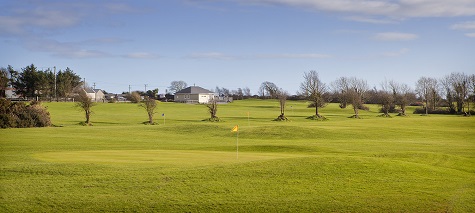
A panoramic view of the course showing the clubhouse in the background
Frank saw the potential that the land had and, being in a tourist area (Hook Head, Loftus Hall, Tintern Abbey, Duncannon Fort, the John F. Kennedy Arboretum and countless sandy beaches are all within a few miles of the area), he decided to take the leap into running a par 3 golf course.
Planning permission to construct and build a par 3 golf course was first submitted to Wexford Co. Council in 2003. Due to strict planning regulations for golf courses, it took two years before permission was granted. Construction work began in June 2005.
The weather Gods were kindly looking down on the Browne brothers as it was a very dry summer that year and construction work was made easier because of it. Construction was completed in September 2005 and within days of the grass being sown on the greens, tees and fairways, the weather broke, with plenty of rain to follow - just the perfect recipe to get the young grass seedlings established. The course was officially opened in May of 2006.
Before construction began they decided that they would build the greens to USGA specifications, and include irrigation at every green. “We wanted to do it properly as many par 3 courses in the region had soil based greens and would be either too wet in winter or too hard and compact in summer”, said Frank. The greens were sown using a fescue/bent mix.
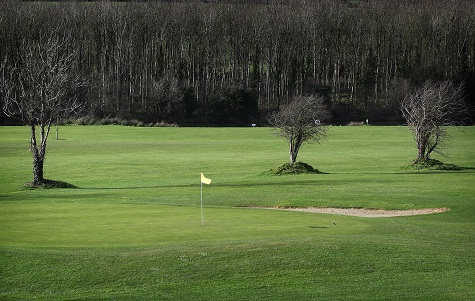
The nearby forest gives a nice backdrop to the course
A stream runs through the entire bottom of the course. During construction they widened part of the stream to form a lake. As well as it creating a nice visual feature to the course, this lake would also be a source of water to fill the above ground 16,000 gallon irrigation tank. This proved vital particularly during dry summers. The stream had a constant flow of water and the levels didn’t drop very much. This made it a valuable and reliable source of water, though some amounts of hand watering still need to be done (which include applying wetting agents). A second lake was constructed further up the course to create a visually pleasing feature to the course.
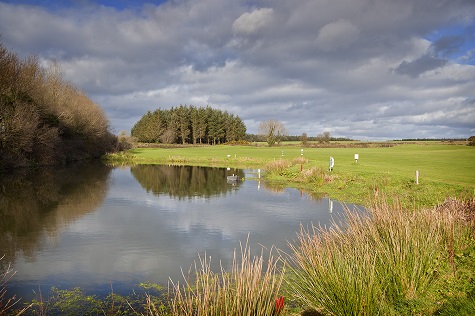
Native fauna and flora have established in the man made lakes
Since building the lakes many wildlife have taken up residence. Ducks and otters have made it their habitat and brown trout have been spotted. Other wildlife that is seen around the course include badgers and deer.
Frank and Ned were jumping into greenkeeping without any prior knowledge or experience of the sportsturf profession. They were both members of New Ross Golf Club but knew the game of golf inside out. However, getting into greenkeeping was an entirely different matter altogether.
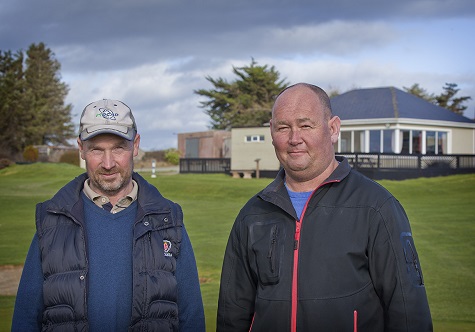
Brothers Ned and Frank Browne
“We got plenty of advice from the sales reps that visited us. They were very helpful. We also read up about greenkeeping in the trade magazines that were out there”, said Frank. “We later joined the Golf Course Superintendents Association of Ireland (GCSAI) and got lots of information from other greenkeepers by attending the regional GCSAI golf outings. This networking proved very valuable to us”, he continued.
When Abbey Par 3 opened in 2006, Ireland was at the peak of an economic boom and most of Ireland was hit by golf mania. That soon came to a crashing end in September 2008, which saw many golfers not renewing their membership the following year. Abbey par 3 was no exception and the downturn affected green fees at the young course. Even the number of par 3 golf societies visiting the course dropped by almost a half.
Not being deterred by this they put their minds together and came up with a plan of adding crazy golf to the business. They did this in 2013 by cleverly using the local landmarks to good use and, with Ned’s block laying skills, built a beautiful crazy golf course, consisting of models of Hook Head lighthouse, Loftus Hall, the main street of the local village of Fethard-On-Sea and many other humorous features. It proved very popular with the locals and tourists visiting the area. The longest hole on the course is 200yds with the shortest being 75 yards.

The crazy golf course with Loftus Hall and Hook Head lighthouse
But they didn’t stop there. In 2014 they incorporated Footee Golf into the Par 3 course. Tee off for each hole was in front of the main tee box and the greens were in front of the par 3 greens. The two sports run in harmony side by side without being in each others way. “Introducing crazy golf and footee golf has meant that we can survive as a business. Had we relied entirely on green fees from the par 3 course back then the business simply would not have survived”, said Ned.
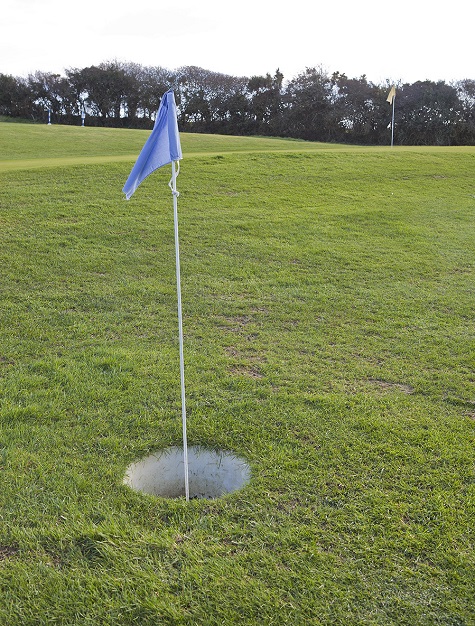
Footee Golf and golf share the same course where the foot golf holes are placed in front of the golf greens
Covid -19
After surviving the financial crisis of 2008 and just when the economy was beginning to recover, Ireland and the world was hit with the coronavirus pandemic. Business was up 20% for Abbey Par 3 in 2019. How did Covid -19 affect Frank and Ned? “In a strange way Covid-19 has been very good for us”, said Frank.
“When golf courses were forced to shut, they were during the quietest times for us anyway. Most of our customers play their golf between April and September. Many of them are tourists who are visiting the area. Covid-19 has seen a big demand in golf and when golf courses re-opened on the 26th of April last we saw a big influx of people come to play our course. On one occasion we had to turn people away so, at the moment, business is booming”.
Course maintenance
Talking to Frank and Ned, as I walked around the course with them, I was amazed at how much knowledge they had learned about turf maintenance over the past fifteen years. They know about the importance of aeration, nutrition and sanding and this showed in the quality of the greens. They were in great shape with a high showing of fescue/bent grass.
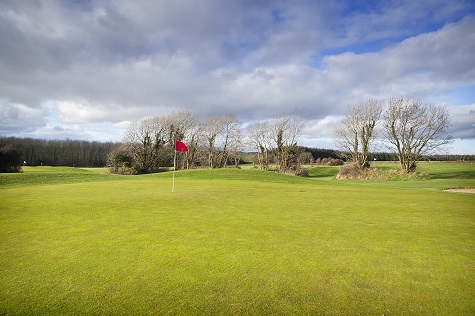
The greens at Abbey par 3 are in excellent condition
Frank and Ned make up the greenkeeping staff at Abbey Par 3. It is a seven day a week commitment but they enjoy the work and get to meet so many interesting people. Frank, in particular, would often spend time behind the counter receiving green fees and making tea/coffee for the clients coming in after a round out on the course.
The greens at Abbey par 3 are mown at 6mm in summer and increased to 8mm in winter. The greens are maintained using a nutritional programme based on seaweed and an organic granular fertilizer. This programme has seen a reduction in the number of disease outbreaks and little flush growth as you would see using non organic granular fertilizer. This has meant a huge saving on spraying and fertilizer costs.
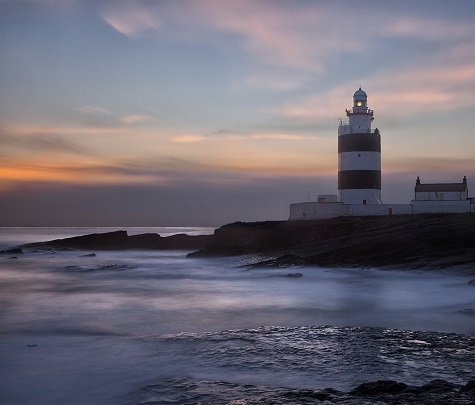
Hook Head lighthouse, Europe’s oldest working lighthouse, is a popular tourist attraction and only 15km from Abbey Par 3 golf course
Hollow coring is done in autumn using 12mm tines. Deep scarifying is also carried out at this time to remove excess thatch followed up with an overseeding of a Fescue/Highland bent grass mix.
The tee boxes are clay based and are fed twice each year. The fairways receive no nutrition. The bunkers around the course are taken out of play during the winter months which saves on raking and topping up with sand.
Sometimes we underestimate the importance of par 3 golf courses. For some they are the stepping stones to joining a full 18 hole golf course. It’s the place where many of us grew up and learned how to play our golf. I hope they will continue to thrive into the future and that Abbey Par 3, in particular, will provide lots of fun for many golfers to come.